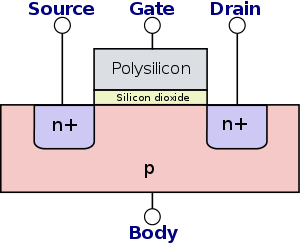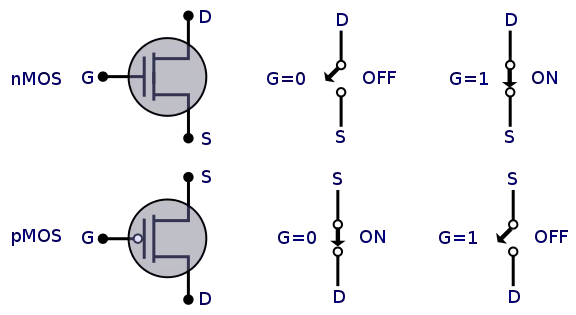| Line 73: | Line 73: | ||
=== Invention === | === Invention === | ||
| − | [[Mohamed M. Atalla]] at [[Bell Labs]] was dealing with the problem of surface states in the late 1950s. He attempted to [[Surface passivation|passivate the surface]] of [[silicon]] through the [[Thermal oxidation|formation of oxide layer]] over it. He thought that growing a very thin high quality thermally grown | + | [[Mohamed M. Atalla]] at [[Bell Labs]] was dealing with the problem of surface states in the late 1950s. He attempted to [[Surface passivation|passivate the surface]] of [[silicon]] through the [[Thermal oxidation|formation of oxide layer]] over it. He thought that growing a very thin high quality thermally grown SiO<sub>2</sub> on top of a clean silicon wafer would neutralize surface states enough to make a practical working field-effect transistor. He wrote his findings in his BTL memos in 1957, before presenting his work at an [[Electrochemical Society]] meeting in 1958.<ref name="kahng">{{cite article |title=Dawon Kahng |url=https://www.invent.org/inductees/dawon-kahng |website=[[National Inventors Hall of Fame]] |access-date=27 June 2019}}</ref><ref name="atalla">{{cite article|title=Martin (John) M. Atalla|publisher=[[National Inventors Hall of Fame]]|year=2009|url=https://www.invent.org/inductees/martin-john-m-atalla|access-date=21 June 2013}}</ref><ref name="Lojek">{{cite book |last1=Lojek |first1=Bo |title=History of Semiconductor Engineering |date=2007 |publisher=Springer Science & Business Media |isbn=978-3540342588 |pages=321–23}}</ref><ref name="Huff34">{{cite book |last1=Huff |first1=Howard |title=High Dielectric Constant Materials: VLSI MOSFET Applications |date=2005 |publisher=Springer Science & Business Media |isbn=978-3540210818 |page=34 |url=https://books.google.com/books?id=kaSmXepnqCMC&pg=PA34}}</ref><ref name="computerhistory">{{cite article|url=https://www.computerhistory.org/siliconengine/metal-oxide-semiconductor-mos-transistor-demonstrated/|title=1960: Metal Oxide Semiconductor (MOS) Transistor Demonstrated|journal=The Silicon Engine: A Timeline of Semiconductors in Computers|publisher=[[Computer History Museum]] |access-date=August 31, 2019}}</ref> This was an important development that enabled MOS technology and silicon [[integrated circuit]] (IC) chips.<ref name="Sah"/> |
The MOSFET was invented when Mohamed Atalla and [[Dawon Kahng]]<ref name="atalla"/><ref name="kahng"/> successfully [[Semiconductor device fabrication|fabricated]] the first working MOSFET device in November 1959.<ref name="Bassett22">{{cite book |last1=Bassett |first1=Ross Knox |title=To the Digital Age: Research Labs, Start-up Companies, and the Rise of MOS Technology |date=2007 |publisher=Johns Hopkins University Press |isbn=978-0801886393 |page=22 |url=https://books.google.com/books?id=UUbB3d2UnaAC&pg=PA22}}</ref> The device is covered by two patents, each filed separately by Atalla and Kahng in March 1960.<ref>US patent 3206670 (1960)</ref><ref>US patent 3102230 (1960)</ref><ref>{{cite article | url = http://www.computerhistory.org/semiconductor/timeline/1948-conception.html | year = 2007 | title = 1948 – Conception of the Junction Transistor | website = The Silicon Engine: A Timeline of Semiconductors in Computers | publisher = Computer History Museum | access-date = 2007-11-02 | archive-url = https://web.archive.org/web/20120419144844/http://www.computerhistory.org/semiconductor/timeline/1948-conception.html | archive-date = 2012-04-19 | url-status = dead }}</ref><ref>US patent 2953486</ref> They published their results in June 1960,<ref>{{cite article |last1=Atalla |first1=M. |author1-link=Mohamed M. Atalla |last2=Kahng |first2=D. |author2-link=Dawon Kahng |title=Silicon–silicon dioxide field induced surface devices |journal=IRE-AIEE Solid State Device Research Conference |publisher=[[Carnegie Mellon University Press]] |date=June 1960}}</ref> at the Solid-State Device Conference held at [[Carnegie Mellon University]].<ref>{{cite article |title=Oral-History: Goldey, Hittinger and Tanenbaum |url=https://ethw.org/Oral-History:Goldey,_Hittinger_and_Tanenbaum |publisher=[[Institute of Electrical and Electronics Engineers]] |date=25 September 2008 |access-date=22 August 2019}}</ref> The same year, Atalla proposed the use of MOSFETs to build [[MOS integrated circuit]] (MOS IC) chips, noting the MOSFET's ease of fabrication.<ref name="Moskowitz"/> | The MOSFET was invented when Mohamed Atalla and [[Dawon Kahng]]<ref name="atalla"/><ref name="kahng"/> successfully [[Semiconductor device fabrication|fabricated]] the first working MOSFET device in November 1959.<ref name="Bassett22">{{cite book |last1=Bassett |first1=Ross Knox |title=To the Digital Age: Research Labs, Start-up Companies, and the Rise of MOS Technology |date=2007 |publisher=Johns Hopkins University Press |isbn=978-0801886393 |page=22 |url=https://books.google.com/books?id=UUbB3d2UnaAC&pg=PA22}}</ref> The device is covered by two patents, each filed separately by Atalla and Kahng in March 1960.<ref>US patent 3206670 (1960)</ref><ref>US patent 3102230 (1960)</ref><ref>{{cite article | url = http://www.computerhistory.org/semiconductor/timeline/1948-conception.html | year = 2007 | title = 1948 – Conception of the Junction Transistor | website = The Silicon Engine: A Timeline of Semiconductors in Computers | publisher = Computer History Museum | access-date = 2007-11-02 | archive-url = https://web.archive.org/web/20120419144844/http://www.computerhistory.org/semiconductor/timeline/1948-conception.html | archive-date = 2012-04-19 | url-status = dead }}</ref><ref>US patent 2953486</ref> They published their results in June 1960,<ref>{{cite article |last1=Atalla |first1=M. |author1-link=Mohamed M. Atalla |last2=Kahng |first2=D. |author2-link=Dawon Kahng |title=Silicon–silicon dioxide field induced surface devices |journal=IRE-AIEE Solid State Device Research Conference |publisher=[[Carnegie Mellon University Press]] |date=June 1960}}</ref> at the Solid-State Device Conference held at [[Carnegie Mellon University]].<ref>{{cite article |title=Oral-History: Goldey, Hittinger and Tanenbaum |url=https://ethw.org/Oral-History:Goldey,_Hittinger_and_Tanenbaum |publisher=[[Institute of Electrical and Electronics Engineers]] |date=25 September 2008 |access-date=22 August 2019}}</ref> The same year, Atalla proposed the use of MOSFETs to build [[MOS integrated circuit]] (MOS IC) chips, noting the MOSFET's ease of fabrication.<ref name="Moskowitz"/> | ||
| Line 91: | Line 91: | ||
The impact of the MOSFET became commercially significant from the late 1960s onwards.<ref>{{cite article |last1=Arns |first1=R. G. |title=The other transistor: early history of the metal–oxide–semiconductor field-effect transistor |journal=[[Engineering Science and Education Journal]] |date=October 1998 |volume=7 |issue=5 |pages=233–40 |doi=10.1049/esej:19980509}}</ref> This led to a revolution in the [[electronics industry]], which has since impacted daily life in almost every way.<ref name="Chan">{{cite book |last1=Chan |first1=Yi-Jen |title=Studies of InAIAs/InGaAs and GaInP/GaAs heterostructure FET's for high speed applications |date=1992 |publisher=[[University of Michigan]] |url=https://books.google.com/books?id=sV4eAQAAMAAJ |page=1 |quote=The Si MOSFET has revolutionized the electronics industry and as a result impacts our daily lives in almost every conceivable way.}}</ref> The invention of the MOSFET has been cited as the birth of modern [[electronics]]<ref>{{cite book |last1=Kubozono |first1=Yoshihiro |last2=He |first2=Xuexia |last3=Hamao |first3=Shino |last4=Uesugi |first4=Eri |last5=Shimo |first5=Yuma |last6=Mikami |first6=Takahiro |last7=Goto |first7=Hidenori |last8=Kambe |first8=Takashi |chapter=Application of Organic Semiconductors toward Transistors |title=Nanodevices for Photonics and Electronics: Advances and Applications |date=2015 |publisher=[[CRC Press]] |isbn=978-9814613750 |page=355 |chapter-url=https://books.google.com/books?id=8wdCCwAAQBAJ&pg=PA355}}</ref> and was central to the microcomputer revolution.<ref>{{cite book |last1=Malmstadt |first1=Howard V. |last2=Enke |first2=Christie G. |last3=Crouch |first3=Stanley R. |title=Making the Right Connections: Microcomputers and Electronic Instrumentation |date=1994 |publisher=[[American Chemical Society]] |isbn=978-0841228610 |page=389 |url=https://books.google.com/books?id=lyJGAQAAIAAJ |quote=The relative simplicity and low power requirements of MOSFETs have fostered today's microcomputer revolution.}}</ref> | The impact of the MOSFET became commercially significant from the late 1960s onwards.<ref>{{cite article |last1=Arns |first1=R. G. |title=The other transistor: early history of the metal–oxide–semiconductor field-effect transistor |journal=[[Engineering Science and Education Journal]] |date=October 1998 |volume=7 |issue=5 |pages=233–40 |doi=10.1049/esej:19980509}}</ref> This led to a revolution in the [[electronics industry]], which has since impacted daily life in almost every way.<ref name="Chan">{{cite book |last1=Chan |first1=Yi-Jen |title=Studies of InAIAs/InGaAs and GaInP/GaAs heterostructure FET's for high speed applications |date=1992 |publisher=[[University of Michigan]] |url=https://books.google.com/books?id=sV4eAQAAMAAJ |page=1 |quote=The Si MOSFET has revolutionized the electronics industry and as a result impacts our daily lives in almost every conceivable way.}}</ref> The invention of the MOSFET has been cited as the birth of modern [[electronics]]<ref>{{cite book |last1=Kubozono |first1=Yoshihiro |last2=He |first2=Xuexia |last3=Hamao |first3=Shino |last4=Uesugi |first4=Eri |last5=Shimo |first5=Yuma |last6=Mikami |first6=Takahiro |last7=Goto |first7=Hidenori |last8=Kambe |first8=Takashi |chapter=Application of Organic Semiconductors toward Transistors |title=Nanodevices for Photonics and Electronics: Advances and Applications |date=2015 |publisher=[[CRC Press]] |isbn=978-9814613750 |page=355 |chapter-url=https://books.google.com/books?id=8wdCCwAAQBAJ&pg=PA355}}</ref> and was central to the microcomputer revolution.<ref>{{cite book |last1=Malmstadt |first1=Howard V. |last2=Enke |first2=Christie G. |last3=Crouch |first3=Stanley R. |title=Making the Right Connections: Microcomputers and Electronic Instrumentation |date=1994 |publisher=[[American Chemical Society]] |isbn=978-0841228610 |page=389 |url=https://books.google.com/books?id=lyJGAQAAIAAJ |quote=The relative simplicity and low power requirements of MOSFETs have fostered today's microcomputer revolution.}}</ref> | ||
| + | |||
| + | ==Importance== | ||
| + | The MOSFET forms the basis of modern electronics,<ref name="McCluskey">{{cite book |last1=McCluskey |first1=Matthew D. |last2=Haller |first2=Eugene E. |title=Dopants and Defects in Semiconductors |date=2012 |publisher=[[CRC Press]] |isbn=978-1439831533 |page=3 |url=https://books.google.com/books?id=fV3RBQAAQBAJ&pg=PA3}}</ref> and is the basic element in most modern [[electronic equipment]].<ref>{{cite article|last1=Daniels|first1=Lee A.|title=Dr. Dawon Kahng, 61, Inventor In Field of Solid-State Electronics|url=https://www.nytimes.com/1992/05/28/nyregion/dr-dawon-kahng-61-inventor-in-field-of-solid-state-electronics.html|website=The New York Times|access-date=1 April 2017|date=28 May 1992}}</ref> It is the most common transistor in electronics,<ref name="kahng"/> and the most widely used [[semiconductor device]] in the world.<ref>{{cite book |last1=Golio |first1=Mike |last2=Golio |first2=Janet |title=RF and Microwave Passive and Active Technologies |date=2018 |publisher=CRC Press |isbn=978-1420006728 |pages=18–12 |url=https://books.google.com/books?id=MCj9jxSVQKIC&pg=SA18-PA2}}</ref> It has been described as the "workhorse of the electronics industry"<ref name="Colinge2016">{{cite book |last1=Colinge |first1=Jean-Pierre |last2=Greer |first2=James C.|title=Nanowire Transistors: Physics of Devices and Materials in One Dimension |date=2016 |publisher=[[Cambridge University Press]] |isbn=978-1107052406 |page=2 |url=https://books.google.com/books?id=FvjUCwAAQBAJ&pg=PA2}}</ref> and "the base technology" of the late 20th to early 21st centuries.<ref name="triumph"/> [[#Scaling|MOSFET scaling]] and [[miniaturization]] (see ''[[List of semiconductor scale examples]]'') have been the primary factors behind the rapid exponential growth of electronic [[semiconductor]] technology since the 1960s,<ref name="Lamba">{{cite article |last1=Lamba |first1=V. |last2=Engles |first2=D. |last3=Malik |first3=S. S. |last4=Verma |first4=M. |title=Quantum transport in silicon double-gate MOSFET |journal=2009 2nd International Workshop on Electron Devices and Semiconductor Technology |date=2009 |pages=1–4 |doi=10.1109/EDST.2009.5166116|isbn=978-1-4244-3831-0 |s2cid=10377971 }}</ref> as the rapid miniaturization of MOSFETs has been largely responsible for the increasing [[transistor density]], increasing performance and decreasing [[power consumption]] of [[integrated circuit]] chips and electronic devices since the 1960s.<ref name="Sridharan">{{cite book |last1=Sridharan |first1=K. |last2=Pudi |first2=Vikramkumar |title=Design of Arithmetic Circuits in Quantum Dot Cellular Automata Nanotechnology |date=2015 |publisher=Springer |isbn=978-3319166889 |page=1 |url=https://books.google.com/books?id=lJ-1BwAAQBAJ&pg=PA1}}</ref> | ||
| + | |||
| + | MOSFETs are capable of [[#Scaling|high scalability]] ([[Moore's law]] and [[Dennard scaling]]),<ref name="Motoyoshi"/> with increasing [[miniaturization]],<ref>{{cite book |last1=Lécuyer |first1=Christophe |title=Making Silicon Valley: Innovation and the Growth of High Tech, 1930-1970 |date=2006 |publisher=[[Chemical Heritage Foundation]] |isbn=9780262122818 |page=273 |url=https://books.google.com/books?id=5TgKinNy5p8C&pg=PA273}}</ref> and can be easily scaled down to smaller dimensions.<ref name="Britannica">{{cite article |last1=Sze |first1=Simon Min |author1-link=Simon Sze |title=Metal–oxide–semiconductor field-effect transistors |url=https://www.britannica.com/technology/semiconductor-device/Metal-oxide-semiconductor-field-effect-transistors |website=[[Encyclopedia Britannica]] |access-date=21 July 2019}}</ref> They consume significantly less power, and allow much higher density, than bipolar transistors.<ref name="Moore"/> MOSFETs can be much smaller than BJTs,<ref name="Bapat">{{cite book|url=https://books.google.com/books?id=PMHig7a-_hIC&pg=PA119|title=Electronic Circuits and Systems : Analog and Digital,1e|last1=Bapat|first1=Y. N.|date=1992|publisher=[[Tata McGraw-Hill Education]]|isbn=978-0-07-460040-5|page=119}}</ref> about one-twentieth of the size by the early 1990s.<ref name="Bapat"/> MOSFETs also have faster switching speed,<ref name="aosmd"/> with rapid on–off [[electronic switch]]ing that makes them ideal for generating [[pulse train]]s,<ref name="electronicdesign">{{cite article |title=Applying MOSFETs to Today's Power-Switching Designs |url=https://www.electronicdesign.com/mosfets/applying-mosfets-today-s-power-switching-designs |website=[[Electronic Design]] |access-date=10 August 2019 |date=23 May 2016}}</ref> the basis for digital signals.<ref>{{cite book |author=B. SOMANATHAN NAIR |title=Digital electronics and logic design |date=2002 |isbn=9788120319561 |publisher=PHI Learning Pvt. Ltd. |quote=Digital signals are fixed-width pulses, which occupy only one of two levels of amplitude. |page=289}}</ref><ref>{{cite book |author=Joseph Migga Kizza |isbn=978-0387204734 |date=2005 |publisher=Springer Science & Business Media |title=Computer Network Security}}</ref> In contrast to BJTs, which more slowly generate analog signals resembling [[sine waves]],<ref name="electronicdesign"/> MOSFETs are also cheaper<ref name="computerhistory-digital"/> and have relatively simple processing steps, resulting in higher [[manufacturing yield]].<ref name="Britannica"/> MOSFETs thus enable [[large-scale integration]] (LSI), and are ideal for [[digital circuits]],<ref>{{cite book |title=2000 Solved Problems in Digital Electronics |date=2005 |publisher=[[Tata McGraw-Hill Education]] |isbn=978-0-07-058831-8 |page=151 |url=https://books.google.com/books?id=N6FDii6_nSEC&pg=PA151}}</ref> as well as [[linear circuit|linear]] [[analog circuits]].<ref name="electronicdesign"/> | ||
| + | |||
| + | The MOSFET has been variously described as the most important [[transistor]],<ref name="Ashley">{{cite book |last1=Ashley |first1=Kenneth L. |title=Analog Electronics with LabVIEW |date=2002 |publisher=[[Prentice Hall Professional]] |isbn=978-0130470652 |page=10 |url=https://books.google.com/books?id=0qkc2f6EXnQC&pg=PA10 |quote=A recent textbook on the subject of analog integrated circuits (Jorns and Martin, 1997) takes the approach that such circuits are now totally dominated by MOSFETs but includes some BJT applications. (...) The MOSFET has gradually taken over as the most important transistor, with increased emphasis on integrated circuits and improved speeds.}}</ref> the most important device in the electronics industry,<ref>{{cite article |last1=Frank |first1=D. J. |last2=Dennard |first2=R. H. |last3=Nowak |first3=E. |last4=Solomon |first4=P. M. |last5=Taur |first5=Y. |title=Device scaling limits of Si MOSFETs and their application dependencies |journal=[[Proceedings of the IEEE]] |date=2001 |volume=89 |issue=3 |pages=259–88 |doi=10.1109/5.915374 |issn=0018-9219}}</ref> arguably the most important device in the [[computing industry]],<ref>{{cite book |last1=Klimecky |first1=Pete Ivan |title=Plasma density control for reactive ion etch variation reduction in industrial microelectronics |date=2002 |publisher=[[University of Michigan]] |page=2 |isbn=9780493885735 |url=https://books.google.com/books?id=oQQeAQAAMAAJ |quote=Arguably the most important device breakthrough for the computing industry, however, occurred in 1960 when Kahng and Atalla proposed and fabricated the first metal–oxide–semiconductor field-effect-transistor, or MOSFET, using a thermally oxidized silicon structure.}}</ref> one of the most important developments in [[semiconductor]] technology,<ref>{{cite book |last1=Deal |first1=Bruce E. |chapter=The Thermal Oxidation of Silicon and Other Semiconductor Materials |title=Semiconductor Materials and Process Technology Handbook: For Very Large Scale Integration (VLSI) and Ultra Large Scale Integration (ULSI) |date=1988 |publisher=Noyes Publications |isbn=978-0815511502 |page=46 |chapter-url=http://www.neoblackpanther.com/materials/Semiconductor-Materials-and-Process-Technology-Handbook.pdf}}</ref> and possibly the most important invention in electronics.<ref>{{cite article |last1=Thompson |first1=S. E. |last2=Chau |first2=R. S. |last3=Ghani |first3=T. |last4=Mistry |first4=K. |last5=Tyagi |first5=S. |last6=Bohr |first6=M. T. |title=In search of "Forever," continued transistor scaling one new material at a time |journal=[[IEEE Transactions on Semiconductor Manufacturing]] |date=2005 |volume=18 |issue=1 |pages=26–36 |doi=10.1109/TSM.2004.841816 |s2cid=25283342 |issn=0894-6507 |quote=In the field of electronics, the planar Si metal–oxide–semiconductor field-effect transistor (MOSFET) is perhaps the most important invention.}}</ref> The MOSFET has been the fundamental building block of modern [[digital electronics]],<ref name="triumph"/> during the [[digital revolution]],<ref name="Wong">{{cite book |last1=Wong |first1=Kit Po |title=Electrical Engineering – Volume II |date=2009 |publisher=[[Encyclopedia of Life Support Systems|EOLSS Publications]] |isbn=978-1905839780 |page=7 |url=https://books.google.com/books?id=4fI8CwAAQBAJ&pg=PA7}}</ref> [[information revolution]], [[information age]],<ref name="Raymer">{{cite book |last1=Raymer |first1=Michael G. |title=The Silicon Web: Physics for the Internet Age |date=2009 |publisher=[[CRC Press]] |isbn=978-1439803127 |page=365 |url=https://books.google.com/books?id=PLYChGDqa6EC&pg=PA365}}</ref> and [[silicon age]].<ref name="Feldman">{{cite book |last1=Feldman |first1=Leonard C. |author1-link=Leonard Feldman |chapter=Introduction |title=Fundamental Aspects of Silicon Oxidation |date=2001 |publisher=[[Springer Science & Business Media]] |isbn=978-3540416821 |pages=1–11 |chapter-url=https://books.google.com/books?id=sV4y2-mWGNIC&pg=PA1}}</ref><ref name="Dabrowski">{{cite book |last1=Dabrowski |first1=Jarek |last2=Müssig |first2=Hans-Joachim |chapter=1.2. The Silicon Age |title=Silicon Surfaces and Formation of Interfaces: Basic Science in the Industrial World |date=2000 |publisher=[[World Scientific]] |isbn=978-9810232863 |pages=[https://archive.org/details/siliconsurfacesf0000dabr/page/3 3–13] |chapter-url=https://books.google.com/books?id=ZlefXcP3tQAC&pg=PA3 |url=https://archive.org/details/siliconsurfacesf0000dabr/page/3 }}</ref> MOSFETs have been the driving force behind the [[computer revolution]], and the technologies enabled by it.<ref name="uspto">{{cite article |title=Remarks by Director Iancu at the 2019 International Intellectual Property Conference |url=https://www.uspto.gov/about-us/news-updates/remarks-director-iancu-2019-international-intellectual-property-conference |website=[[United States Patent and Trademark Office]] |date=June 10, 2019 |access-date=20 July 2019 |archive-url=https://web.archive.org/web/20191217200937/https://www.uspto.gov/about-us/news-updates/remarks-director-iancu-2019-international-intellectual-property-conference |archive-date=17 December 2019 |url-status=dead }}</ref><ref>{{cite book|author1-link=Jerry G. Fossum |last1=Fossum |first1=Jerry G. |last2=Trivedi |first2=Vishal P. |title=Fundamentals of Ultra-Thin-Body MOSFETs and FinFETs |date=2013 |publisher=Cambridge University Press |isbn=978-1107434493 |page=vii |url=https://books.google.com/books?id=zZJfAAAAQBAJ&pg=PR7}}</ref><ref>{{cite book |last1=Chen |first1=Wai Kai |title=The Electrical Engineering Handbook |date=2004 |publisher=[[Elsevier]] |isbn=978-0080477480 |page=109 |url=https://books.google.com/books?id=qhHsSlazGrQC&pg=PA109}}</ref> The rapid progress of the electronics industry during the late 20th to early 21st centuries was achieved by rapid [[MOSFET scaling]] ([[Dennard scaling]] and [[Moore's law]]), down to the level of [[nanoelectronic]]s in the early 21st century.<ref>{{cite book |last1=Franco |first1=Jacopo |last2=Kaczer |first2=Ben |last3=Groeseneken |first3=Guido |title=Reliability of High Mobility SiGe Channel MOSFETs for Future CMOS Applications |date=2013 |publisher=Springer Science & Business Media |isbn=978-9400776630 |pages=1–2 |url=https://books.google.com/books?id=PnrGBAAAQBAJ&pg=PA1}}</ref> The MOSFET revolutionized the world during the information age, with its high density enabling a [[computer]] to exist on a few small IC chips rather than filling a room,<ref>{{cite book |last1=Cressler |first1=John D. |last2=Mantooth |first2=H. Alan |title=Extreme Environment Electronics |date=2017 |publisher=[[CRC Press]] |isbn=978-1-351-83280-9 |page=959 |url=https://books.google.com/books?id=4AlEDwAAQBAJ&pg=PA959 |quote=While the bipolar junction transistor was the first transistor device to take hold in the integrated circuit world, there is no question that the advent of MOSFETs, an acronym for metal-oxide-semiconductor field-effect transistor, is what truly revolutionized the world in the so-called information age. The density with which these devices can be made has allowed entire computers to exist on a few small chips rather than filling a room.}}</ref> and later making possible digital [[communications technology]] such as [[smartphones]].<ref name="uspto"/> | ||
| + | |||
| + | The MOSFET is the [[List of best-selling electronic devices|most widely manufactured device]] in history.<ref name="computerhistory2018">{{cite article |title=13 Sextillion & Counting: The Long & Winding Road to the Most Frequently Manufactured Human Artifact in History |url=https://www.computerhistory.org/atchm/13-sextillion-counting-the-long-winding-road-to-the-most-frequently-manufactured-human-artifact-in-history/ |date=April 2, 2018 |website=[[Computer History Museum]] |access-date=28 July 2019}}</ref><ref name="Baker">{{cite book |last1=Baker |first1=R. Jacob |title=CMOS: Circuit Design, Layout, and Simulation |date=2011 |publisher=John Wiley & Sons |isbn=978-1118038239 |page=7 |url=https://books.google.com/books?id=kxYhNrOKuJQC&pg=PA7}}</ref> The MOSFET generates annual sales of $295 billion as of 2015.<ref>{{cite book |last1=Maloberti |first1=Franco |last2=Davies |first2=Anthony C. |chapter=History of Electronic Devices |title=A Short History of Circuits and Systems: From Green, Mobile, Pervasive Networking to Big Data Computing |date=2016 |publisher=[[IEEE Circuits and Systems Society]] |isbn=978-8793609860 |pages=59-70 (65-6) |chapter-url=https://ieee-cas.org/sites/default/files/a_short_history_of_circuits_and_systems-_ebook-_web.pdf}}</ref> Between 1960 and 2018, an estimated total of 13 [[sextillion]] MOS transistors have been manufactured, accounting for at least 99.9% of all transistors.<ref name="computerhistory2018"/> Digital integrated circuits such as [[microprocessor]]s and [[Computer memory|memory devices]] contain thousands to billions of integrated MOSFETs on each device, providing the basic switching functions required to implement [[logic gate]]s and data storage. There are also memory devices which contain at least a trillion MOS transistors, such as a 256 [[Gigabyte|GB]] [[microSD]] [[memory card]], larger than the number of [[stars]] in the [[Milky Way]] [[galaxy]].<ref name="Colinge2016"/> As of 2010, the operating principles of modern MOSFETs have remained largely the same as the original MOSFET first demonstrated by [[Mohamed Atalla]] and [[Dawon Kahng]] in 1960.<ref>{{cite book |last1=Schwierz |first1=Frank |last2=Wong |first2=Hei |last3=Liou |first3=Juin J. |title=Nanometer CMOS |date=2010 |publisher=Pan Stanford Publishing |isbn=978-9814241083 |page=5 |url=https://books.google.com/books?id=IljcLHKwM3EC&pg=PA5}}</ref><ref>{{cite article |last1=Ye |first1=Peide |last2=Ernst |first2=Thomas |last3=Khare |first3=Mukesh V. |title=The Nanosheet Transistor Is the Next (and Maybe Last) Step in Moore's Law |url=https://spectrum.ieee.org/semiconductors/devices/the-nanosheet-transistor-is-the-next-and-maybe-last-step-in-moores-law |access-date=6 November 2019 |journal=[[IEEE Spectrum]] |date=30 July 2019|doi=10.1109/MSPEC.2019.8784120 |s2cid=199439071 }}</ref> | ||
| + | |||
| + | The [[US Patent and Trademark Office]] calls the MOSFET a "groundbreaking invention that transformed life and culture around the world"<ref name="uspto"/> and the [[Computer History Museum]] credits it with "irrevocably changing the human experience."<ref name="triumph"/> The MOSFET was also the basis for [[Nobel Prize]] winning breakthroughs such as the [[quantum Hall effect]]<ref name="Lindley">{{cite article |last1=Lindley |first1=David |title=Focus: Landmarks – Accidental Discovery Leads to Calibration Standard |journal=[[Physics (magazine)|Physics]] |date=15 May 2015 |volume=8 |doi=10.1103/Physics.8.46 }}</ref> and the [[charge-coupled device]] (CCD),<ref name="Williams"/> though there was never any Nobel Prize given for the MOSFET itself.<ref>{{cite book |last1=Woodall |first1=Jerry M. |author1-link=Jerry Woodall |title=Fundamentals of III-V Semiconductor MOSFETs |date=2010 |publisher=Springer Science & Business Media |isbn=978-1441915474 |page=2 |url=https://books.google.com/books?id=sk2SrZH3xEcC&pg=PA2}}</ref> In a 2018 note on [[Jack Kilby]]'s [[Nobel Prize for Physics]] for his part in the invention of the integrated circuit, the [[Royal Swedish Academy of Sciences]] specifically mentioned the MOSFET and the microprocessor as other important inventions in the evolution of [[microelectronics]].<ref name="Nobel">{{cite article |title=Advanced information on the Nobel Prize in Physics 2000 |url=https://www.nobelprize.org/uploads/2018/06/advanced-physicsprize2000.pdf |website=[[Nobel Prize]] |date=June 2018 |access-date=17 August 2019}}</ref> The MOSFET is also included on the [[list of IEEE milestones]] in electronics,<ref>{{cite article |title=Milestones:List of IEEE Milestones |url=http://ethw.org/Milestones:List_of_IEEE_Milestones |publisher=[[Institute of Electrical and Electronics Engineers]] |access-date=25 July 2019}}</ref> and its inventors Mohamed Atalla and Dawon Kahng entered the [[National Inventors Hall of Fame]] in 2009.<ref name="kahng"/><ref name="atalla"/> | ||
==See also== | ==See also== | ||
Revision as of 13:46, 6 September 2024

MOSFET (Metal-Oxide-Semiconductor Field-Effect-Transistor), also known as the MOS transistor (metal–oxide–silicon transistor) or IGFET (Insulated-Gate Field-Effect Transistor), is a type of insulated-gate field-effect transistor that is fabricated by the controlled oxidation of a semiconductor (typically silicon) and utilizes an insulator (such as SiO2) between the gate and the body. Today, the MOSFET is the most common type of transistor for both digital and analog circuits. The voltage of the gate terminal determines the electrical conductivity of the device; this ability to change conductivity with the amount of applied voltage can be used for amplifying or switching electronic signals.
The MOSFET was invented by Mohamed M. Atalla and Dawon Kahng at Bell Labs in 1959, and first presented in 1960. It is the basic building block of modern electronics, and the most frequently manufactured device in history, with an estimated total of 13 sextillion (1022) MOSFETs manufactured between 1960 and 2018.[1] It is the dominant semiconductor device in digital and analog integrated circuits (ICs),[2] and the most common power device.[3] It is a compact transistor that has been miniaturised and mass-produced for a wide range of applications, revolutionizing the electronics industry and the world economy, and being central to the digital revolution, silicon age and information age. MOSFET scaling and miniaturization has been driving the rapid exponential growth of electronic semiconductor technology since the 1960s, and enables high-density ICs such as memory chips and microprocessors.
A key advantage of a MOSFET is that it requires almost no input current to control the load current, when compared with bipolar junction transistors (BJTs). In an enhancement mode MOSFET, voltage applied to the gate terminal can increase the conductivity from the "normally off" state. In a depletion mode MOSFET, voltage applied at the gate can reduce the conductivity from the "normally on" state.[4] MOSFETs are also capable of high scalability, with increasing miniaturization, and can be easily scaled down to smaller dimensions. They also have faster switching speed (ideal for digital signals), much smaller size, consume significantly less power, and allow much higher density (ideal for large-scale integration), compared to BJTs. MOSFETs are also cheaper and have relatively simple processing steps, resulting in high manufacturing yield.
MOSFETs can either be manufactured as part of MOS integrated circuit chips or as discrete MOSFET devices (such as a power MOSFET), and can take the form of single-gate or multi-gate transistors. Since MOSFETs can be made with either p-type or n-type semiconductors (PMOS or NMOS logic, respectively), complementary pairs of MOSFETs can be used to make switching circuits with very low power consumption: CMOS (Complementary MOS) logic.
The name "metal–oxide–semiconductor" (MOS) typically refers to a metal gate, oxide insulation, and semiconductor (typically silicon).[5] However, the "metal" in the name MOSFET is sometimes a misnomer, because the gate material can also be a layer of polysilicon (polycrystalline silicon). Because originally the gate was made from metal, the name metal-oxide semiconductor (MOS) stuck, as today the gates are typically made of polycrystalline sillicon, although in recent years, advancements in technology reintroduced metallic gates in order to solve various performance issues. Along with oxide, different dielectric materials can also be used with the aim of obtaining strong channels with smaller applied voltages. The MOS capacitor is also part of the MOSFET structure.
Contents
Overview
Process
- Further information: doping, n-type semiconductor, and p-type semiconductor
The basic starting material for most integrated circuits based on MOSFET technology is typically Silicon (Si); though other processes such as silicon-germanium (Si1−xGex) also exist. Silicon is a very brittle metalloid. It has the same structure as a diamond in elemental form (the actual structure is a 3D tetrahedral, just like carbon). It's a Group IV element - each silicon forming single covalent bonds with four adjacent silicon atoms. Because all of its valence electrons are involved in chemical bonds, pure silicon is quite a poor conductor of electricity. It's possible to raise the conductivity of silicon by introducing impurities, known as dopants, into the silicon lattice through a processes known as doping. Similar results can also be achieved by adding group V elements (which have 5 bonding electrons vs 4 for Si) such as phosphorus or arsenic. By inserting those group V elements into the silicon lattice it can still bond to the 4 original silicon atoms neighbors. The 5th valence electron is loosely bound to that group V element. The thermal vibrations is enough make that electron free to move - leaving positive ions and a free electron. It is this free electron that can carry current thereby increasing the conductivity of the lattice. The process forms a new semiconductor called an n-type semiconductor. The processes can be done with a group III element as well. This creates a situation where each atom is now short by an electron. The missing electron (or hole) propagates about the lattice. The hole acts as a positive carrier gaining the name p-type semiconductor.
A diode is the junction between p-type semiconductors and n-type semiconductors. When the voltage on the p-type semiconductors, known as anode, is raised above the n-type semiconductors, known as a cathode, the diode is said to be forward biased. When that happens, current flows. When the anode voltage is equal to or less than the cathode voltage, the diode is reverse biased - at which point very little current flows. Varying the voltage between the gate and body modulates the conductivity of this layer effectively controlling the current flow between drain and source.
MOS sandwich-like structure is created by superimposing several layers of conducting and insulating together. The actual process involves oxidation of the silicon, doping of the silicon using dopants, and etching of metal wires and contacts. Transistors are built on a pure and flawless single crystals of silicon. Each transistor consists of a body - the silicon wafer. The body is often grounded, often considered the reference node. Each transistor has a stack of the conducting gate that sits on top of an isolating glass (SiO2), and the substrate (also known as the body).
An nMOS transistor is built with a p-type body with two regions of n-type semiconductor adjacent to the gate called the source and the drain. For all practical purposes they are physically equivalent and can be used interchangeably. A pMOS transistor is built with an n-type body with two regions of p-type semiconductors adjacent to the gate.
Controlling Gate
Both pMOS and nMOS have a controlling gate. The controlling gate, as the name implies, controls the flow of electrons between the source and drain.
nMOS gate behavior
- Main article: nMOS transistor
In the nMOS transistor, since the body is grounded, the p-n junctions of the source and drain to body are reverse-biased. If the voltage at the gate is raised, an electric field starts to build up - attracting free electrons to the underside of the Si-SiO2 interface. When the voltage is high enough, the electrons end up filling all the holes and a thin region under the gate called the channel gets inverted to act as an n-type semiconductor - creating a conducting path from the source to the drain, allowing current to flow. When the transistor is at that state, we say the transistor is ON. If the gate is grounded, little to no current flows through the reverse-biased junction. When that happens, we say the transistor is OFF.
pMOS gate behavior
- Main article: pMOS transistor
In the pMOS transistor, the behavior and setup is the complement of the nMOS transistor. The body is held at positive voltage. When the gate is also positive - the source and drain are reverse-biased. When that happens, no current flows and we say the transistor is OFF.
When the voltage at the gate is lowered, positive charges are attracted to the underside of the Si-SiO2 interface. When the voltage gets sufficiently low the channel gets inverted - creating a conducting path from the source to the drain, allowing current to flow. Because the behavior of a pMOS transistor is the opposite of that of an nMOS transistor, the symbol for pMOS transistor is identical to that of nMOS with an additional bubble on the gate. That bubble is known as an inversion bubble.
When dealing with digital logic there are generally only have two distinct values - ON and OFF, 1 and 0, or HIGH and LOW. The positive voltage of the transistor is called VDD (or POWER or PWR). VDD represents the logic 1 value in digital circuits. In TTL logic, the VDD voltage levels were usually around 5 volts. Today's transistors cannot really withstand such high voltages - they are typically in the 1.5V to 3.3V range. The low voltage is often called GROUND (or GND or VSS). VSS represents the logic 0. It is also normally set to 0 volts.
Modes of operation
| This section is empty; you can help add the missing info by editing this page. |
Symbols
There is no one standard that is commonly accepted across all organizations. Typically individual design groups adopt their own notations. Generally speaking, however, most follow the designs shown below which consists of a lone for the channel with the source and drain leaving it at right angles and then bending back at right angles outwards. Each device has a gate (G), drain (D), and a source (S), A distinction is sometimes made for enhancement mode where the channel is broken down into three smaller lines; it is sometimes drawn as a dotted line instead as well. Depletion mode devices have a solid line instead, this is due to the channel existing prior to power being applied.
Sometimes a fourth terminal for the body (B) is show. In discrete MOSFETs, the body lead is connected internally to the source. When that's the case, the body is also omitted from the symbol. When the bulk is shown, it is sometimes sometimes angled to meet up with the source. In ICs with a common bulk, the bulk is typically not shown and instead an inverting bubble is used to represent a PMOS.
| Channel | Depletion MOSFET | Enhancement MOSFT | ||
|---|---|---|---|---|
| W/ bulk | W/O bulk | W/ bulk | W/O bulk | |
| N-type |  |
 |
 |

|
 |
 |

| ||
| P-type |  |
 |
 |

|
 |
 |

| ||
Early history
Background
- Main article: Field-effect transistor
The basic principle of the field-effect transistor (FET) was first proposed by Austrian physicist Julius Edgar Lilienfeld in 1926, when he filed the first patent for an insulated-gate field-effect transistor.[6] Over the course of next two years he described various FET structures. In his configuration, aluminum formed the metal and aluminum oxide the oxide, while copper sulfide was used as a semiconductor. However, he was unable to build a practical working device.[7] The FET concept was later also theorized by German engineer Oskar Heil in the 1930s and American physicist William Shockley in the 1940s.[8] There was no working practical FET built at the time, and none of these early FET proposals involved thermally oxidized silicon.[7]
Semiconductor companies initially focused on bipolar junction transistors (BJTs) in the early years of the semiconductor industry. However, the junction transistor was a relatively bulky device that was difficult to manufacture on a mass-production basis, which limited it to a number of specialised applications. FETs were theorized as potential alternatives to junction transistors, but researchers were unable to build practical FETs, largely due to the troublesome surface state barrier that prevented the external electric field from penetrating into the material.[9] In the 1950s, researchers had largely given up on the FET concept, and instead focused on BJT technology.[10]
Invention
Mohamed M. Atalla at Bell Labs was dealing with the problem of surface states in the late 1950s. He attempted to passivate the surface of silicon through the formation of oxide layer over it. He thought that growing a very thin high quality thermally grown SiO2 on top of a clean silicon wafer would neutralize surface states enough to make a practical working field-effect transistor. He wrote his findings in his BTL memos in 1957, before presenting his work at an Electrochemical Society meeting in 1958.[11][12][13][14][8] This was an important development that enabled MOS technology and silicon integrated circuit (IC) chips.[15]
The MOSFET was invented when Mohamed Atalla and Dawon Kahng[12][11] successfully fabricated the first working MOSFET device in November 1959.[16] The device is covered by two patents, each filed separately by Atalla and Kahng in March 1960.[17][18][19][20] They published their results in June 1960,[21] at the Solid-State Device Conference held at Carnegie Mellon University.[22] The same year, Atalla proposed the use of MOSFETs to build MOS integrated circuit (MOS IC) chips, noting the MOSFET's ease of fabrication.[9]
Commercialization
The advantage of the MOSFET was that it was relatively compact and easy to mass-produce compared to the competing planar junction transistor,[23] but the MOSFET represented a radically new technology, the adoption of which would have required spurning the progress that Bell had made with the bipolar junction transistor (BJT). The MOSFET was also initially slower and less reliable than the BJT.[24]
In the early 1960s, MOS technology research programs were established by Fairchild Semiconductor, RCA Laboratories, General Microelectronics (led by former Fairchild engineer Frank Wanlass) and IBM.[25] In 1962, Steve R. Hofstein and Fred P. Heiman at RCA built the first MOS integrated circuit chip. The following year, they collected all previous works on FETs and gave a theory of operation of the MOSFET.[26] CMOS was developed by Chih-Tang Sah and Frank Wanlass at Fairchild in 1963.[27] The first CMOS integrated circuit was later built in 1968 by Albert Medwin.[28]
The first formal public announcement of the MOSFET's existence as a potential technology was made in 1963. It was then first commercialized by General Microelectronics in May 1964, followed Fairchild in October 1964. GMe's first MOS contract was with NASA, which used MOSFETs for spacecraft and satellites in the Interplanetary Monitoring Platform (IMP) program and Explorers Program.[25] The early MOSFETs commercialized by General Microelectronics and Fairchild were p-channel (PMOS) devices for logic and switching applications.[8] By the mid-1960s, RCA were using MOSFETs in their consumer products, including FM radio, television and amplifiers.[29] In 1967, Bell Labs researchers Robert Kerwin, Donald Klein and John Sarace developed the self-aligned gate (silicon-gate) MOS transistor, which Fairchild researchers Federico Faggin and Tom Klein adapted for integrated circuits in 1968.[30]
MOS revolution
- Main article: MOS revolution
The development of the MOSFET led to a revolution in electronics technology, called the MOS revolution[31] or MOSFET revolution,[32] fuelling the technological and economic growth of the early semiconductor industry.
The impact of the MOSFET became commercially significant from the late 1960s onwards.[33] This led to a revolution in the electronics industry, which has since impacted daily life in almost every way.[34] The invention of the MOSFET has been cited as the birth of modern electronics[35] and was central to the microcomputer revolution.[36]
Importance
The MOSFET forms the basis of modern electronics,[37] and is the basic element in most modern electronic equipment.[38] It is the most common transistor in electronics,[11] and the most widely used semiconductor device in the world.[39] It has been described as the "workhorse of the electronics industry"[40] and "the base technology" of the late 20th to early 21st centuries.[10] MOSFET scaling and miniaturization (see List of semiconductor scale examples) have been the primary factors behind the rapid exponential growth of electronic semiconductor technology since the 1960s,[41] as the rapid miniaturization of MOSFETs has been largely responsible for the increasing transistor density, increasing performance and decreasing power consumption of integrated circuit chips and electronic devices since the 1960s.[42]
MOSFETs are capable of high scalability (Moore's law and Dennard scaling),[43] with increasing miniaturization,[44] and can be easily scaled down to smaller dimensions.[45] They consume significantly less power, and allow much higher density, than bipolar transistors.[46] MOSFETs can be much smaller than BJTs,[47] about one-twentieth of the size by the early 1990s.[47] MOSFETs also have faster switching speed,[3] with rapid on–off electronic switching that makes them ideal for generating pulse trains,[48] the basis for digital signals.[49][50] In contrast to BJTs, which more slowly generate analog signals resembling sine waves,[48] MOSFETs are also cheaper[51] and have relatively simple processing steps, resulting in higher manufacturing yield.[45] MOSFETs thus enable large-scale integration (LSI), and are ideal for digital circuits,[52] as well as linear analog circuits.[48]
The MOSFET has been variously described as the most important transistor,[2] the most important device in the electronics industry,[53] arguably the most important device in the computing industry,[54] one of the most important developments in semiconductor technology,[55] and possibly the most important invention in electronics.[56] The MOSFET has been the fundamental building block of modern digital electronics,[10] during the digital revolution,[57] information revolution, information age,[58] and silicon age.[59][60] MOSFETs have been the driving force behind the computer revolution, and the technologies enabled by it.[61][62][63] The rapid progress of the electronics industry during the late 20th to early 21st centuries was achieved by rapid MOSFET scaling (Dennard scaling and Moore's law), down to the level of nanoelectronics in the early 21st century.[64] The MOSFET revolutionized the world during the information age, with its high density enabling a computer to exist on a few small IC chips rather than filling a room,[65] and later making possible digital communications technology such as smartphones.[61]
The MOSFET is the most widely manufactured device in history.[66][67] The MOSFET generates annual sales of $295 billion as of 2015.[68] Between 1960 and 2018, an estimated total of 13 sextillion MOS transistors have been manufactured, accounting for at least 99.9% of all transistors.[66] Digital integrated circuits such as microprocessors and memory devices contain thousands to billions of integrated MOSFETs on each device, providing the basic switching functions required to implement logic gates and data storage. There are also memory devices which contain at least a trillion MOS transistors, such as a 256 GB microSD memory card, larger than the number of stars in the Milky Way galaxy.[40] As of 2010, the operating principles of modern MOSFETs have remained largely the same as the original MOSFET first demonstrated by Mohamed Atalla and Dawon Kahng in 1960.[69][70]
The US Patent and Trademark Office calls the MOSFET a "groundbreaking invention that transformed life and culture around the world"[61] and the Computer History Museum credits it with "irrevocably changing the human experience."[10] The MOSFET was also the basis for Nobel Prize winning breakthroughs such as the quantum Hall effect[71] and the charge-coupled device (CCD),[72] though there was never any Nobel Prize given for the MOSFET itself.[73] In a 2018 note on Jack Kilby's Nobel Prize for Physics for his part in the invention of the integrated circuit, the Royal Swedish Academy of Sciences specifically mentioned the MOSFET and the microprocessor as other important inventions in the evolution of microelectronics.[74] The MOSFET is also included on the list of IEEE milestones in electronics,[75] and its inventors Mohamed Atalla and Dawon Kahng entered the National Inventors Hall of Fame in 2009.[11][12]
See also
References
- ↑ Laws, David (April 2, 2018). 13 Sextillion & Counting: The Long & Winding Road to the Most Frequently Manufactured Human Artifact in History. Computer History Museum.
- ↑ 2.0 2.1 (2002) Analog Electronics with LabVIEW. Prentice Hall Professional, 10. ISBN 978-0130470652. "A recent textbook on the subject of analog integrated circuits (Jorns and Martin, 1997) takes the approach that such circuits are now totally dominated by MOSFETs but includes some BJT applications. (...) The MOSFET has gradually taken over as the most important transistor, with increased emphasis on integrated circuits and improved speeds."
- ↑ 3.0 3.1 Cite error: Invalid
<ref>tag; no text was provided for refs namedaosmd - ↑ (2007) "§8.2 The depletion mode MOSFET", Electronic Circuits. Technical Publications, 812. ISBN 978-81-8431-284-3.
- ↑ Cite error: Invalid
<ref>tag; no text was provided for refs namedcomputerhistory-transistor - ↑ Lilienfeld, Julius Edgar (1926-10-08) "Method and apparatus for controlling electric currents" (US patent 1745175A)
- ↑ 7.0 7.1 (1998) "Highlights Of Silicon Thermal Oxidation Technology", Silicon materials science and technology. The Electrochemical Society, 183. ISBN 978-1566771931.
- ↑ 8.0 8.1 8.2 1960: Metal Oxide Semiconductor (MOS) Transistor Demonstrated. The Silicon Engine: A Timeline of Semiconductors in Computers. {{{issue}}}
- ↑ 9.0 9.1 (2016) Advanced Materials Innovation: Managing Global Technology in the 21st century. John Wiley & Sons, 165–67. ISBN 978-0470508923.
- ↑ 10.0 10.1 10.2 10.3 The Foundation of Today's Digital World: The Triumph of the MOS Transistor
- ↑ 11.0 11.1 11.2 11.3 Dawon Kahng
- ↑ 12.0 12.1 12.2 Martin (John) M. Atalla
- ↑ (2007) History of Semiconductor Engineering. Springer Science & Business Media, 321–23. ISBN 978-3540342588.
- ↑ (2005) High Dielectric Constant Materials: VLSI MOSFET Applications. Springer Science & Business Media, 34. ISBN 978-3540210818.
- ↑ Cite error: Invalid
<ref>tag; no text was provided for refs namedSah - ↑ (2007) To the Digital Age: Research Labs, Start-up Companies, and the Rise of MOS Technology. Johns Hopkins University Press, 22. ISBN 978-0801886393.
- ↑ US patent 3206670 (1960)
- ↑ US patent 3102230 (1960)
- ↑ 1948 – Conception of the Junction Transistor
- ↑ US patent 2953486
- ↑ Silicon–silicon dioxide field induced surface devices. IRE-AIEE Solid State Device Research Conference. {{{issue}}}
- ↑ Oral-History: Goldey, Hittinger and Tanenbaum
- ↑ (2016) Advanced Materials Innovation: Managing Global Technology in the 21st century. John Wiley & Sons, 165 & 181. ISBN 978-0470508923. "Despite its success, the planar junction transistor had its own problems with which to contend. Most importantly, it was a fairly bulky device and difficult to manufacture on a mass production basis, which limited it to a number of specialized applications. Scientists and engineers believed that only a field effect transistor (FET), the type that Shockley first conceived of in the late 1940s but never could get to work properly, held out the hope of a compact, truly mass produced transistor that could be miniaturized for a wide range of uses. (...) A major step in this direction was the invention of the "MOS" process. (...) But Moore particularly believed that the future of mass-produced, low-cost, and high-capacity semiconductor memories was in MOS integrated chips, that is, integrated circuits composed of MOS transistors. Here he thought Intel could really make its mark on a truly breakthrough innovation."
- ↑ (2002) To the Digital Age: Research Labs, Start-up Companies, and the Rise of MOS Technology. Johns Hopkins University Press, 53–54. ISBN 978-0-8018-6809-2.
- ↑ 25.0 25.1 (2015) "Chapter 3: NASA's Role in the Manufacture of Integrated Circuits", Historical Studies in the Societal Impact of Spaceflight. NASA, 149-250 (239-42). ISBN 978-1-62683-027-1.
- ↑ (2007) Electronics: The Life Story of a Technology, 84.
- ↑ Cite error: Invalid
<ref>tag; no text was provided for refs namedcomputerhistory1963 - ↑ Semiconductor translating circuit (US patent 3390314)
- ↑ (2005) Current Sources and Voltage References: A Design Reference for Electronics Engineers. Elsevier, 185. ISBN 978-0-08-045555-6.
- ↑ 1968: Silicon Gate Technology Developed for ICs
- ↑ (2007) To the Digital Age: Research Labs, Start-up Companies, and the Rise of MOS Technology. Johns Hopkins University Press, 3. ISBN 978-0801886393.
- ↑ (2003) ULSI Process Integration III: Proceedings of the International Symposium. The Electrochemical Society, 46. ISBN 978-1566773768.
- ↑ The other transistor: early history of the metal–oxide–semiconductor field-effect transistor. Engineering Science and Education Journal. 7 (5): 233–40. doi:10.1049/esej:19980509
- ↑ (1992) Studies of InAIAs/InGaAs and GaInP/GaAs heterostructure FET's for high speed applications. University of Michigan, 1. "The Si MOSFET has revolutionized the electronics industry and as a result impacts our daily lives in almost every conceivable way."
- ↑ (2015) "Application of Organic Semiconductors toward Transistors", Nanodevices for Photonics and Electronics: Advances and Applications. CRC Press, 355. ISBN 978-9814613750.
- ↑ (1994) Making the Right Connections: Microcomputers and Electronic Instrumentation. American Chemical Society, 389. ISBN 978-0841228610. "The relative simplicity and low power requirements of MOSFETs have fostered today's microcomputer revolution."
- ↑ (2012) Dopants and Defects in Semiconductors. CRC Press, 3. ISBN 978-1439831533.
- ↑ Dr. Dawon Kahng, 61, Inventor In Field of Solid-State Electronics
- ↑ (2018) RF and Microwave Passive and Active Technologies. CRC Press, 18–12. ISBN 978-1420006728.
- ↑ 40.0 40.1 (2016) Nanowire Transistors: Physics of Devices and Materials in One Dimension. Cambridge University Press, 2. ISBN 978-1107052406.
- ↑ Quantum transport in silicon double-gate MOSFET. 2009 2nd International Workshop on Electron Devices and Semiconductor Technology. {{{issue}}}: 1–4. doi:10.1109/EDST.2009.5166116
- ↑ (2015) Design of Arithmetic Circuits in Quantum Dot Cellular Automata Nanotechnology. Springer, 1. ISBN 978-3319166889.
- ↑ Cite error: Invalid
<ref>tag; no text was provided for refs namedMotoyoshi - ↑ (2006) Making Silicon Valley: Innovation and the Growth of High Tech, 1930-1970. Chemical Heritage Foundation, 273. ISBN 9780262122818.
- ↑ 45.0 45.1 Metal–oxide–semiconductor field-effect transistors
- ↑ Cite error: Invalid
<ref>tag; no text was provided for refs namedMoore - ↑ 47.0 47.1 (1992) Electronic Circuits and Systems : Analog and Digital,1e. Tata McGraw-Hill Education, 119. ISBN 978-0-07-460040-5.
- ↑ 48.0 48.1 48.2 Applying MOSFETs to Today's Power-Switching Designs
- ↑ B. SOMANATHAN NAIR (2002). Digital electronics and logic design. PHI Learning Pvt. Ltd., 289. ISBN 9788120319561. "Digital signals are fixed-width pulses, which occupy only one of two levels of amplitude."
- ↑ Joseph Migga Kizza (2005). Computer Network Security. Springer Science & Business Media. ISBN 978-0387204734.
- ↑ Cite error: Invalid
<ref>tag; no text was provided for refs namedcomputerhistory-digital - ↑ (2005) 2000 Solved Problems in Digital Electronics. Tata McGraw-Hill Education, 151. ISBN 978-0-07-058831-8.
- ↑ Device scaling limits of Si MOSFETs and their application dependencies. Proceedings of the IEEE. 89 (3): 259–88. doi:10.1109/5.915374
- ↑ (2002) Plasma density control for reactive ion etch variation reduction in industrial microelectronics. University of Michigan, 2. ISBN 9780493885735. "Arguably the most important device breakthrough for the computing industry, however, occurred in 1960 when Kahng and Atalla proposed and fabricated the first metal–oxide–semiconductor field-effect-transistor, or MOSFET, using a thermally oxidized silicon structure."
- ↑ (1988) "The Thermal Oxidation of Silicon and Other Semiconductor Materials", Semiconductor Materials and Process Technology Handbook: For Very Large Scale Integration (VLSI) and Ultra Large Scale Integration (ULSI). Noyes Publications, 46. ISBN 978-0815511502.
- ↑ In search of "Forever," continued transistor scaling one new material at a time. IEEE Transactions on Semiconductor Manufacturing. 18 (1): 26–36. doi:10.1109/TSM.2004.841816
- ↑ (2009) Electrical Engineering – Volume II. EOLSS Publications, 7. ISBN 978-1905839780.
- ↑ (2009) The Silicon Web: Physics for the Internet Age. CRC Press, 365. ISBN 978-1439803127.
- ↑ (2001) "Introduction", Fundamental Aspects of Silicon Oxidation. Springer Science & Business Media, 1–11. ISBN 978-3540416821.
- ↑ (2000) "1.2. The Silicon Age", Silicon Surfaces and Formation of Interfaces: Basic Science in the Industrial World. World Scientific, 3–13. ISBN 978-9810232863.
- ↑ 61.0 61.1 61.2 Remarks by Director Iancu at the 2019 International Intellectual Property Conference
- ↑ (2013) Fundamentals of Ultra-Thin-Body MOSFETs and FinFETs. Cambridge University Press, vii. ISBN 978-1107434493.
- ↑ (2004) The Electrical Engineering Handbook. Elsevier, 109. ISBN 978-0080477480.
- ↑ (2013) Reliability of High Mobility SiGe Channel MOSFETs for Future CMOS Applications. Springer Science & Business Media, 1–2. ISBN 978-9400776630.
- ↑ (2017) Extreme Environment Electronics. CRC Press, 959. ISBN 978-1-351-83280-9. "While the bipolar junction transistor was the first transistor device to take hold in the integrated circuit world, there is no question that the advent of MOSFETs, an acronym for metal-oxide-semiconductor field-effect transistor, is what truly revolutionized the world in the so-called information age. The density with which these devices can be made has allowed entire computers to exist on a few small chips rather than filling a room."
- ↑ 66.0 66.1 13 Sextillion & Counting: The Long & Winding Road to the Most Frequently Manufactured Human Artifact in History
- ↑ (2011) CMOS: Circuit Design, Layout, and Simulation. John Wiley & Sons, 7. ISBN 978-1118038239.
- ↑ (2016) "History of Electronic Devices", A Short History of Circuits and Systems: From Green, Mobile, Pervasive Networking to Big Data Computing. IEEE Circuits and Systems Society, 59-70 (65-6). ISBN 978-8793609860.
- ↑ (2010) Nanometer CMOS. Pan Stanford Publishing, 5. ISBN 978-9814241083.
- ↑ The Nanosheet Transistor Is the Next (and Maybe Last) Step in Moore's Law. IEEE Spectrum. {{{issue}}}. doi:10.1109/MSPEC.2019.8784120
- ↑ Focus: Landmarks – Accidental Discovery Leads to Calibration Standard. Physics. 8 ({{{issue}}}). doi:10.1103/Physics.8.46
- ↑ Cite error: Invalid
<ref>tag; no text was provided for refs namedWilliams - ↑ (2010) Fundamentals of III-V Semiconductor MOSFETs. Springer Science & Business Media, 2. ISBN 978-1441915474.
- ↑ Advanced information on the Nobel Prize in Physics 2000
- ↑ Milestones:List of IEEE Milestones


